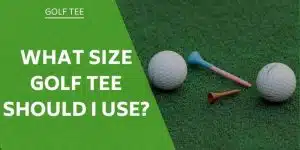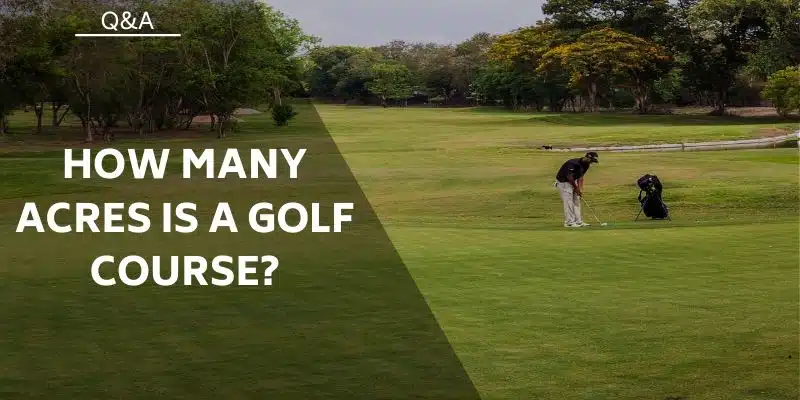Every golfer, from a beginner to the top pros, plays with either a draw or a fade. If that is the case, which one is better, a draw vs a fade?
Let’s compare the differences: fade vs draw golf shots. For right-handed players, a fade curves from left to right, while a draw curves from right to left. Regarding distance, draws often travel further due to a lower trajectory and more roll after landing, while fades offer better control with a steeper descent and less roll.
But if you want to improve your golf game, you will want all the information to use your fade or draw to your benefit. Read on for how to hit a fade and how to hit a draw. You’ll also learn more differences, benefits, and FAQs about fade vs draw.
I’ll also cover the fades and draws of the pros to inspire you!
What is a Fade and Draw in Golf?
There are different golf shot types to shape your shots depending on how you are hitting your driver. A fade and draw are shots that cause the ball to finish off center, not to be mistaken for a slice and hook. The difference between fade and draw is in the direction for right-handed and left-handed golfers. For right-handed golfers, a fade in golf is a shot that starts on the left and curves towards the middle as you can see from the image below.
How To Fade A Golf Ball
A fade is often mistaken for a slice which happens when the clubface is open to the path and target line of the golf ball causing it to curve too much to the right. The draw is a shot that starts on the right and curves towards the middle; however, it becomes a hook when it goes too far left.
How To Draw A Golf Ball
Fade vs Draw: Key Differences
When choosing between a fade and a draw in golf, understanding the key differences can help you determine which shot is best suited for your game:
- Direction: A fade moves from left to right (for right-handed players), while a draw moves from right to left.
- Distance: Generally, a draw can outdistance a fade due to its lower trajectory and topspin. This makes the ball roll more after landing.
- Control: Fades tend to be easier to control for many golfers, especially beginners, as they have a steeper angle of descent and more backspin. This ensures the ball doesn’t roll as much after landing.
- Use on the Course: Fades are often beneficial when dealing with hazards on the left or when bunkers on the left protect the green. On the other hand, drawings can be advantageous on dogleg left holes or when wind conditions favor a right-to-left ball flight.
It’s crucial to remember that while there are distinct characteristics for both the fade and draw, the best shot largely depends on the golfer’s comfort, the specific scenario on the course, and the desired outcome.
How to Hit a Fade
Many golfers suffer from the dreaded slice, with disastrous results when hitting a fade. They often go deep in the rough or even out of bounds. Eliminating the slice requires only a few minor tweaks to achieve a controlled fade.
The first thing to understand is that a fade requires an open clubface at impact. You want to shape the ball, right to left, about 3 to 10 yards. The more you open the clubface, the more left to right it will go. But remember, opening the clubface too far could be one, but not all, of the reasons for the slice.
Before we look at the setup, the grip has to be corrected.
- Grip the club normally, but strengthen the grip on your left hand. A stronger grip with more pressure on the left hand will prevent your wrists from rolling over, resulting in a draw.
- Next, rotate your right hand towards the left. Don’t overdo it, but try to see the knuckles of the right hand. This will weaken the grip making it easier not to roll the wrists and to hit a controlled fade.
- Now the setup, you want to open your stance and align your feet left of the target. Again, don’t overdo it.
- With an open clubface and being aligned left of the target, all you have to do is swing along the path of your feet. Consider placing the ball slightly forward in your stance.
Some players try to manufacture the fade by manipulating the golf swing, bringing the clubface from outside to inside. This can work, but just adds more “thinking” to the process and introduces more things that can go wrong.
How to Hit a Draw
To hit a draw golf shot, you would logically require some reversal of the technique used for the fade. For the draw, we don’t want to weaken the grip, and the right hand will now play a more important role.
- Instead of rotating the right hand towards the left, turn it away to hide the knuckles.
- Place the ball opposite your left armpit, and adjust your stance to a closed position. Your alignment should be right of the target as you want the ball to curve from the right back to the middle of the fairway.
- With this setup and grip, your wrists will now roll over, producing the draw you are looking for.
The Benefits of a Draw vs Fade
In the golf fade vs draw battle, there are pros and cons to either shot shape that make the fade or draw better.
The draw normally will have a lower trajectory and a pronounced topspin. This will tend to give you more distance and greater rollout. The bad news is that if you are offline, you will travel further into trouble, making a recovery more difficult and adding another shot to your scorecard.
A fade produces a higher trajectory and with a backspin, will land more gently and settle quickly with less rollout. The error when you miss your line should be less damaging. The fade will also travel around 5 to 10 yards shorter than a draw, which may or may not be a disadvantage.
The object of the exercise should be to eliminate one side of the golf course. Controlling your draw or fade and hit the fairway more consistently will improve your overall score and enjoyment much more than the variance in distance. In golf, you can’t always rely on a straight shot; sometimes, one of the two shot shapes will come in handy.
Selecting The Best Option
Once you have managed to play and control your natural shot consistently, you can start to practice the other one. Now you can choose a draw if a dogleg is left ahead, and fade to a dogleg right off the tee. On an approach to the green, you can run the ball to the back of the green or land it softly with a fade if the pin placement is near the front.
Which Pros Hit Fades and Draws?

It is interesting to hear the opinions of some of the top pros, past, and present. Many think that some courses are better played predominantly with a draw or a fade.
- Lee Trevino was famous for his uniquely low fade off the tee and his claim that fades win tournaments. Augusta, home of the Masters, is known as a course that favors the draw, especially doglegs to the left on holes 2, 9, 10, and 13, with only 18 requiring a fade. Notably, Trevino never won at Augusta, yet Nicklaus, famous for his “power fade,” won there six times.
- Tiger Woods and Rory McIlroy are both successful power fade players.
- Martin Kymer is one that battled to adapt and become proficient at both shots.
- Dustin Johnson changed from playing a draw to a fade, and the list continues.
- Jack Nicklaus, known for his power fades, says you shouldn’t try to hit fades unless you can first draw.
His advice to play the draw is to start from the ground up with the feet and legs leading. This sets up a swing path into the ball with a closing clubface on impact. Now all you need to do is set up aiming left, open the clubface slightly, and make the same swing. Jack makes it so simple.
Interestingly, a poll was taken once asking which was “cooler” and which was more effective. As might be expected, about 30% of respondents were non-committal, 60% voted the draw was cool, and 10%, not cool.
On the question of effectiveness, the tables were turned, with 60% voting the fade more effective and 10% saying voting against it.
Frequently Asked Questions
Is it Better to Draw or Fade?
The fade draw battle is a bit complicated on both sides. Many players argue that the draw is traditionally better, which is why many professional golfers prefer it, but they are starting to take up the fade more.
When looking into the question, “Is a draw or fade better?” One important thing to consider is the player’s goal and their level. If you’re looking to get more distance, then the fade golf shot is better, but if you want more control, then the draw golf shot is better. All in all the better shot shape is the one that feels most natural to the player.
What Goes Further, Draw or Fade?
Theoretically, if everything else remained the same, the draw and the fade are supposed to have the same distance. However, in the draw vs fade distance battle, the draw takes the crown. This is because a draw will more often travel further than a fade because it has a lower loft than fade shots. Draws also have less spin, which translates to the ball moving further after it lands.
Is it Easier to Control a Draw or Fade?
The fade is definitely much easier to control than the draw, which is why it’s perfect for beginners. This is because fade shots tend to be steeper and have more ball spin, so the golf ball doesn’t bounce or roll as much. Draw shots on the hand are a bit trickier and often tend to go a bit too far left, turning into hooks instead.
Does Tiger Draw or Fade?
In most of his rounds, you will notice that Tiger Woods prefers the fade when there is room for it, although his usual go-to tee shot is his slappy cut. His fade has some clubface rotation which is why it’s not just any ordinary fade but a power fade. When it comes to power fade vs draw, Tiger is well known for the former, and he likes to refer to it as a cut.
Final Thoughts
Draw vs fade in golf: what are the differences? The debate between fade vs draw remains an evergreen topic for enthusiasts and professionals alike.
- To recap, a fade, predominantly seen in right-handed players, arcs from left to right, offering a steeper descent and enhanced control.
- Conversely, a draw moves from right to left, boasting a lower trajectory that often results in added distance due to extended roll.
Both shots come with their distinct advantages. When evaluating the benefits, a fade’s predictability can be a boon for beginners, whereas the draw’s potential for added yardage appeals to those chasing distance.
Notable pros in the golf world have their distinct preferences too. Lee Trevino was renowned for his fade, while legends like Tiger Woods exhibit mastery over the power fade. Conversely, many professionals lean into the draw for specific courses and conditions.
Ultimately, whether you’re team fade or team draw, understanding the nuances and benefits of each shot is paramount in elevating your golf game.
Nick is the founder of GolfSpan and an avid golfer. He's not quite a pro but has over 15 years of experience playing and coaching golfers worldwide. His mission is to bring the golfing community a better experience when it comes to choosing the right golf gear and finding the right setup for your game.








